Anatomy of a Photo: Cornering on Cobbles

A lot of things taken for granted in Cycling go swiftly out the window when cobblestones are introduced to bicycle and rider. The notion that your wheels should both be pointed in the same direction at any given moment, for instance, or that that they should in some way be in alignment with the direction of travel of the rider/bicycle unit, such as it is. Not true, in fact. As it turns out, wheels can move wildly in any maner of directions and not greatly impact forward motion. Another misconception is this notion that one needs to have their handlebars reliably in hand while whisking through a corner or that the direction the handlebars are pointing should be in the direction of travel. Also untrue.
Riding cobbles is a matter of going full gas over the secteurs, no holds barred. The faster you go, the more your bike cascades over the tops of the stones; as the bike flails along, the rider links together recovery after recovery to stave off the imminent crash caused by any of the above conditions going catawampus. Riding the pavé is basically like a toddler learning to walk: always one step away from a face-plant.
For me, though, the biggest challenge is recuperation during those intense efforts. Over the years, I have gotten good at faking it and stealing a few deep breaths during short windows of opportunity, like when the pressure comes off the pedals briefly when cornering. On the cobbles, however, this matter is complicated somewhat by the bouncing wheels, jackhammering of the bars and saddle, and the certainty of an imminent crash.
Which leads me to conclude that while endurance, strength, and interval training will all form critical elements of my training for Keepers Tour 2013, I’m going to also make a point of learning how to take recovery breaths with a tightly clenched bunghole as I try to keep from shitting myself. That’s going to be a differentiator for sure.


@mxlmax When you pedal it’s inevitable that a crank gets *stuck* at the bottom every half-pedal revolution. I agree that it looks more likely he’s coasting than pedaling but we don’t know, which was my point.
Here’s Gustav Larsen doing it wrong.
Did some offroad driving yesterday. Yes, driving. I know. That aside, similarly to riding the cobbles, after I finished driving this part of the course I said the same thing I did when I came off the first section of cobbles: “Oh, it can handle that. I don’t need to worry about all that other crap I do with this thing.”
@Buck Rogers
We have 100 year old cobbles in Seattle and had them in St. Paul where I grew up. I thought I knew what cobbles were.
Not so much.
The issue with cornering on cobbles as well is that you can’t stop pedaling because you pretty much come to a stop after 2 seconds.
@frank – is it just me or is there something wrong, just wrong, posting this image from this poster on this site???
Discuss….PLEASE!
@The Potato Man
That’s a great shot. Those rims/tires look so tiny for his gargantuan form.
@mxlmax
Front skewers usually get fucked up during wheel changes. Though, even if he likes it that way, it wouldn’t be his only Rule violation. Check out those shorts!
@Rob
I’ll also submit I was doing that instead of riding the Cogal.
@frank
The shorts are suited to accommodate the legs. His own set of Rules.
@TBONE
Merckx, that is awesome!
@frank
My local cobbles are gravel. C’est dommage. Donc, I ride the cx bike more often now that it is fall.
Boy, oh, boy. The hairnet. The awesome, huge windshield, er, shades. The Daisy Dukes bib shorts. The white Belgian booties. The white bidon cages. The steel machine. The black rims + silver spokes + silver hubs. A lot goin’ on there! And, the awesome tricolour hat of the gal in the dress in the background!
And then, then we get to the final two sentences from Frank. Ha! Amazing. I actually like to work on taking quick sips from my bidon during training rides when I’m out of breath as practice for races & rides. Nothing like cobble and clenched bodily valves, but along the lines of trying to practice for certain conditions.
I generally hate replays of bad injuries or photos but gotta say, I love that photo of Gustav Larsen. Hoping he wasn’t too badly hurt, but it’s just such a goddamn shocking moment captured forever.
@frank
That’s what our best roads look like over here
@Ron
A pedants writes – Gustav Larsson
@Ken Ho
Actuall, leaning your bike more than your body is a well established technique for cornering of road. It allows you to load your tyres more vertically for better grip and lets you stay on top of the bike should it start to drift (something I believe Kelly was renowned for). It is equally applicable to cornering on the road.
On a different note, I feel much better about our roads here now after seeing the pics of the cobbles. Our A roads are often nice, B roads are a mix, with lots of really coarse chip seal, C roads are rubbish though often smoother as the chips have sunk into hot tar over many summers.
However, I’m never going to complain ever again. If I were to do a Pave tour, I would prepare by looking for the roughest crap I could find.
@frank
There is something about that picture that instantly made me think, “I don’t remember Fronk crashing….”
For good measure – some random punter
@The Potato Man
@Ken Ho
I think The Potato Man is right on this one. I recall an article written by Bernard Hinault (no less) from Winning Magazine in the late ’80’s that describes the correct cornering technique. He was unequivocal that it was not the motorcycle technique with the leg out, but rather the push the bike down across your shoulders technique. The reasons for this were explained thus;
On a motorcycle, you have the motor driving the wheels. This acts by creating more force (centripital?) on the contact patch in a more horizontal (outward) direction. The suggestion is that by leaning the leg out toward the inside of the turn, you are more effictively loading the contact patch in the direction the tire is wanting to go.
On a bike, the wheels aren’t ‘self accelerating’ and so the prime contact patch is more in a vertical dimension. By pushing the bike down and across your body, you are weighting the contact patch more efficiently in a vertical dimension.
Proper cornering technique shouldn’t change based on terrain… Weight the inside arm & outside leg, countersteer into the corner and leave enough extension in the outside leg to compensate for a slide. Whether you’re tearing up the DH course at Mont-Sainte-Anne or blasting through the Arenberg, you’ve got the maximum of traction and control working for you following that technique.
@sthilzy
Another interesting point about this picture versus the Larsson one is that modern, strapless pedals have the advantage of releasing spontaneously in a crash. The Larsson pic being a fine case in point. Look at the Frebert picture; both he and the other rider have crashed and still have feet strapped in. This could not have been good for one’s knees as well as increasing the danger of being clattered by one’s bike as you tumble.
Yeah, but if you hit hard enough, your feet come out of your shoes. When you crawl to the roadside, they’re still conveniently strapped to the pedals. I only used this tactic once.
@mouse
Back in the past when I rode a motorbike, someone told me the knee down technique was used by bike racers for two reasons, one to feel the edge of the track and secondly to actually decrease traction on the back wheel by pushing against the tarmac and allowing the rear (driven) wheel to keep spinning faster in the turn then once back upright on the straight there was no real need for acceleration – hence the wheelie popping on the way out of corners… Not sure how true all of this actually is but clearly that makes dropping the knee on a non-motor bike purely a matter of style as neither of these would play into riding.
Keeping the bike more upright and shifting weight around though allows much greater traction at speed in the corner because more of the tyre is actually gripping in the direction of travel because more of the force is going down through the road and providing greater grip. When I did ride motor bikes, the weight shifting technique actually allowed for less steering and leaning, and therefore faster cornering to get round the same curves – and for Joe Blow riders like me was far more useful than trying to lean the bike right over and get the knee down. But it did rely on stabilising the bike by pushing as hard as possible on the highside leg – which is a technique someone alluded to here a while ago (can’t remember where) when cornering. It also seems to work quite well at slow speeds as well.
On a bicycle, I reckon the weight shift technique works, as does countersteering (when at speed) but whether they originated in motorcycle or bicycle racing, who knows!? Would love to see pictures of a tophatted dude on a penny farthing with his knee down, proving that we the riders of the bicycle are the mothers of invention….
I hated Physics at school, but I reckon if I’d listened a bit better I might just trust my bike in the corners a little more……